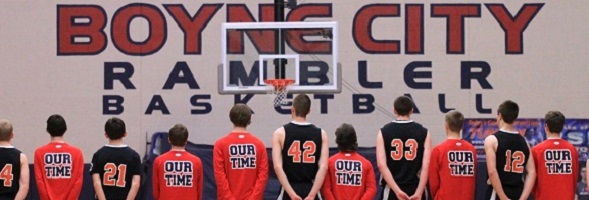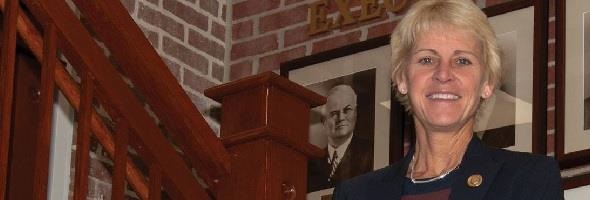
Graduation of Multi-Sport Athletes
December 8, 2014
By David Smith
Boyne City athletic director
Editor’s Note: This is reprinted with permission from the Petoskey News-Review, which is publishing semi-regular columns written by athletic directors for the northwest region of the Lower Peninsula. Click for more sports coverage from the News-Review.
There are many important topics today that relate to high school sports. I was honored when asked to write a brief column about a current topic of my choice in the high sports world. This particular topic, student-athletes specializing in one sport, is something that is happening more and more.
It’s hard to pinpoint exactly why this is, but it often times seems to boil down to unrealistic expectations from several parties that an athlete is capable of being a legitimate college or higher-level athlete.
Don’t get me wrong, we have a plethora of outstanding athletes in Northern Michigan. The facts are, however, that about 98 out of 100 high school athletes never play collegiate sports of any kind at any level. Also, less than one percent of high school athletes receive a scholarship of any kind to a Division I school.
I don’t want to tell someone not to have that dream. In fact, I think that is an awesome dream to have. I had that goal growing up and was fortunate to be able to play a few different sports at a small Division III college. It helped me grow immensely as a person, and I’m very thankful for that experience. I just can’t emphasize enough how we need to all have realistic expectations for our student athletes, whether it’s the athletes themselves, or parents, coaches, administrators, etc.
I think one thing we can all do to help this is to emphasize the process more than the outcome. The funny thing is getting the process right and enjoying it almost always leads to positive outcomes. The process is where all the hard work is put in. The process is where good character is developed, and that’s one of the most important traits we can help young individuals develop.
Many high school athletes are also too busy and compete too much. The amount of young athletes competing year-round for sports is getting out of control. Sure, sometimes it works out and an athlete will really improve by doing this, but more often than not, they get burned out and when it’s actually that sport in-season, they are toast and go through the motions. I know from a coaching standpoint I want athletes hungry to compete every time out.
Being that busy also means very little time for athletes to improve their overall athleticism (stronger, faster, quicker, more explosive, better endurance, etc.). Skills take a back seat too because most athletes are just playing games and not focusing on skill work. I’d rather take an athlete who trains to become more athletic and works on skills for several months than one who plays AAU or something of that nature. I know that has its place for a very few individuals, but most young athletes need way more work on their athleticism and skills before being ready for something like AAU.
I get specializing in one sport if you are undoubtedly a Division I athlete that will likely play professionally. Or maybe it’s someone who goes to a big high school and they aren’t very talented so the only way they can play is to focus really hard on one sport. I get those occurrences.
I would argue, however, that even the Division I-type individuals will nine times out of 10 benefit more from playing another sport because they aren’t going to work hard enough by themselves to make the gains. They would then also be refreshed and ready to get after it once the season arrives. With that, our schools up here will always have a hard time competing at the regional and state level if we don’t have all of our best athletes playing two or three sports. It blows me away how good some of our teams in the area could fare if this happened.
This column is not meant to be negative. It’s just some food for thought. I haven’t been at this very long, but it’s something I’ve seen happen more and more in the last 10 years. I’ve just always been a big fan of the multiple sport athlete and experienced first-hand how much a school can benefit when a group of talented athletes go through and they all play a minimum of two sports.
At the end of the day, we cannot forget what I’d consider the main purpose of athletics at this level. That is, to help young individuals leave our schools with experiences and life lessons that will help them as they pursue careers and go on with other facets of their lives.

NFHS Voice: Leadership Continues at NADC
December 17, 2019
By Karissa Niehoff
NFHS Executive Director
In the history of high school sports, the early 1970s will always be remembered first and foremost for the passage of Title IX in 1972 – legislation that sparked the growth of girls sports in the United States.
A year earlier, however, the National Federation of State High School Associations made a decision that has impacted education-based athletics in an equally significant manner.
Recognizing the future growth of the high school athletic directors profession, the NFHS started the National Conference of High School Directors of Athletics in February 1971. A total of 355 athletics directors attended the first conference in St. Louis, followed by another 257 at the December 1971 gathering in Columbus, Ohio.
The national conference for high school athletic directors has been held annually in December since that time, and on Friday, December 13, at the Gaylord National Resort and Convention Center in National Harbor, Maryland, more than 2,100 athletic administrators were scheduled to convene for the 50th National Athletic Directors Conference (NADC).
The growth of the high school athletic administration profession as well as the NADC was additionally fueled in 1977 when the NFHS formed the National Interscholastic Athletic Administrators Association (NIAAA), a national professional organization for high school athletic directors. Membership in the NIAAA expanded rapidly and, in 2006, it became its own organization. Since that time, the NFHS – the national leader and advocate for high school athletics and performing arts – and the NIAAA have worked together annually to sponsor the NADC.
Without a doubt, athletic directors are the leaders of education-based athletics in our nation’s high schools. They have an endless list of responsibilities and set the tone for the overall success of a school’s athletics and/or activities program.
In recent releases of “The NFHS Voice,” we have noted the significant role that athletic directors play with regard to the educational direction of a school’s athletic program, as well as ensuring that security measures are in place for after-school events.
Unlike national conferences for some groups, professional development is among the main reasons that athletic directors attend this annual conference. They know that they are entrusted with key leadership roles and want to provide a safe and fun experience for student-athletes in their schools.
This year, 40 workshops were offered on key issues related to athletic directors' tasks, including coaching coaches, social media, effective communication, managing fan behavior, event management, generating new sources of revenue, creating positive parent culture and promoting multi-sport participation.
In addition, the NIAAA offered 52 Leadership Training classes, on topics from legal issues, to marketing and promotions, to managing fields and equipment, to working with students with disabilities.
Very simply, high school athletic directors are the key leaders in our nation’s education-based athletic programs. Local schools depend on these individuals to lead their athletics programs. Our member state high school associations depend on these men and women to help lead state events and initiatives. And the NFHS and NIAAA look to athletic administrators for leadership at the national level. We appreciate the tremendous service they provide our nation’s young people!
Dr. Karissa L. Niehoff is in her second year as executive director of the National Federation of State High School Associations (NFHS) in Indianapolis, Indiana. She is the first female to head the national leadership organization for high school athletics and performing arts activities and the sixth full-time executive director of the NFHS, which celebrated its 100th year of service during the 2018-19 school year. She previously was executive director of the Connecticut Association of Schools-Connecticut Interscholastic Athletic Conference for seven years.

